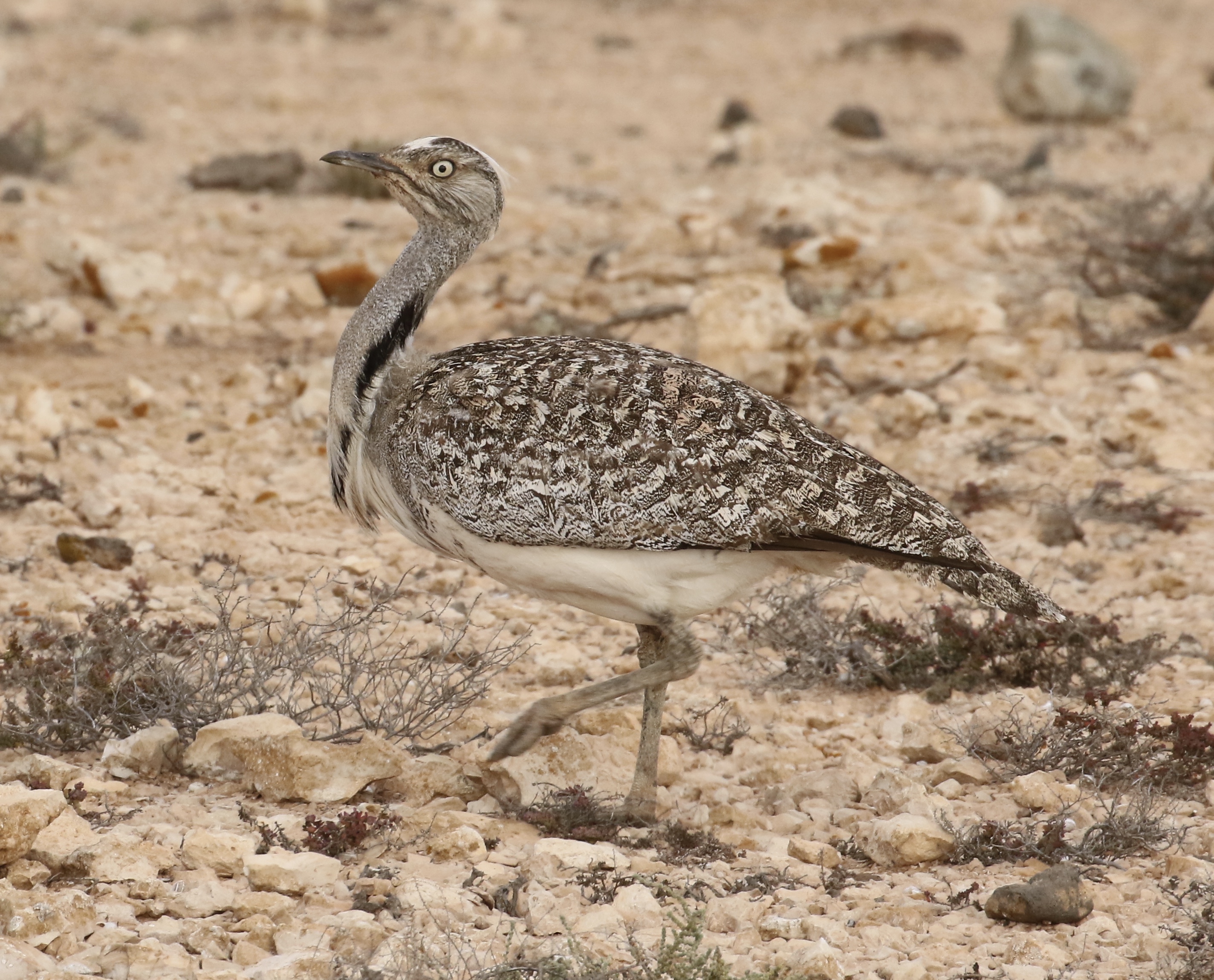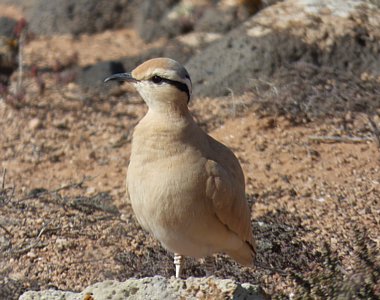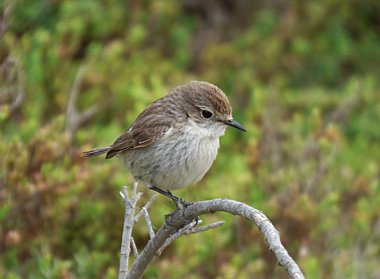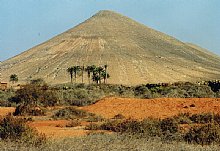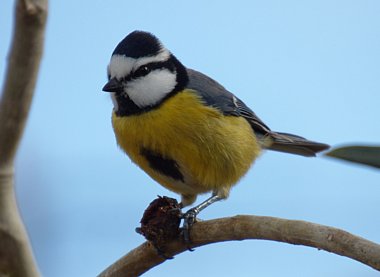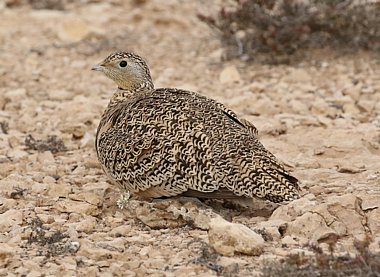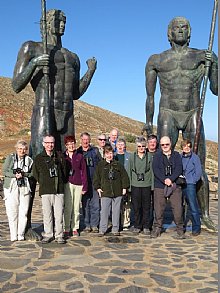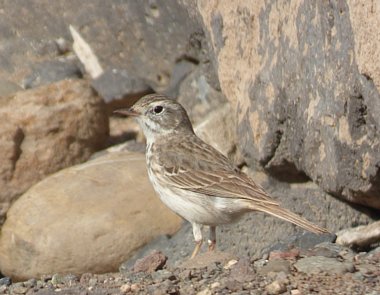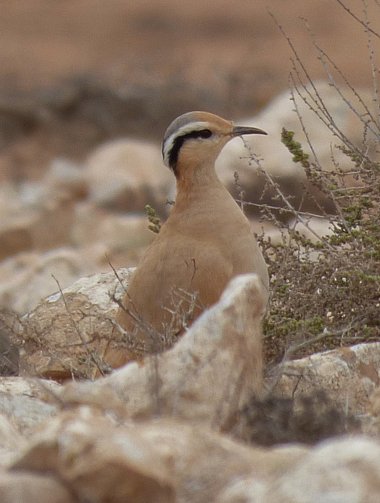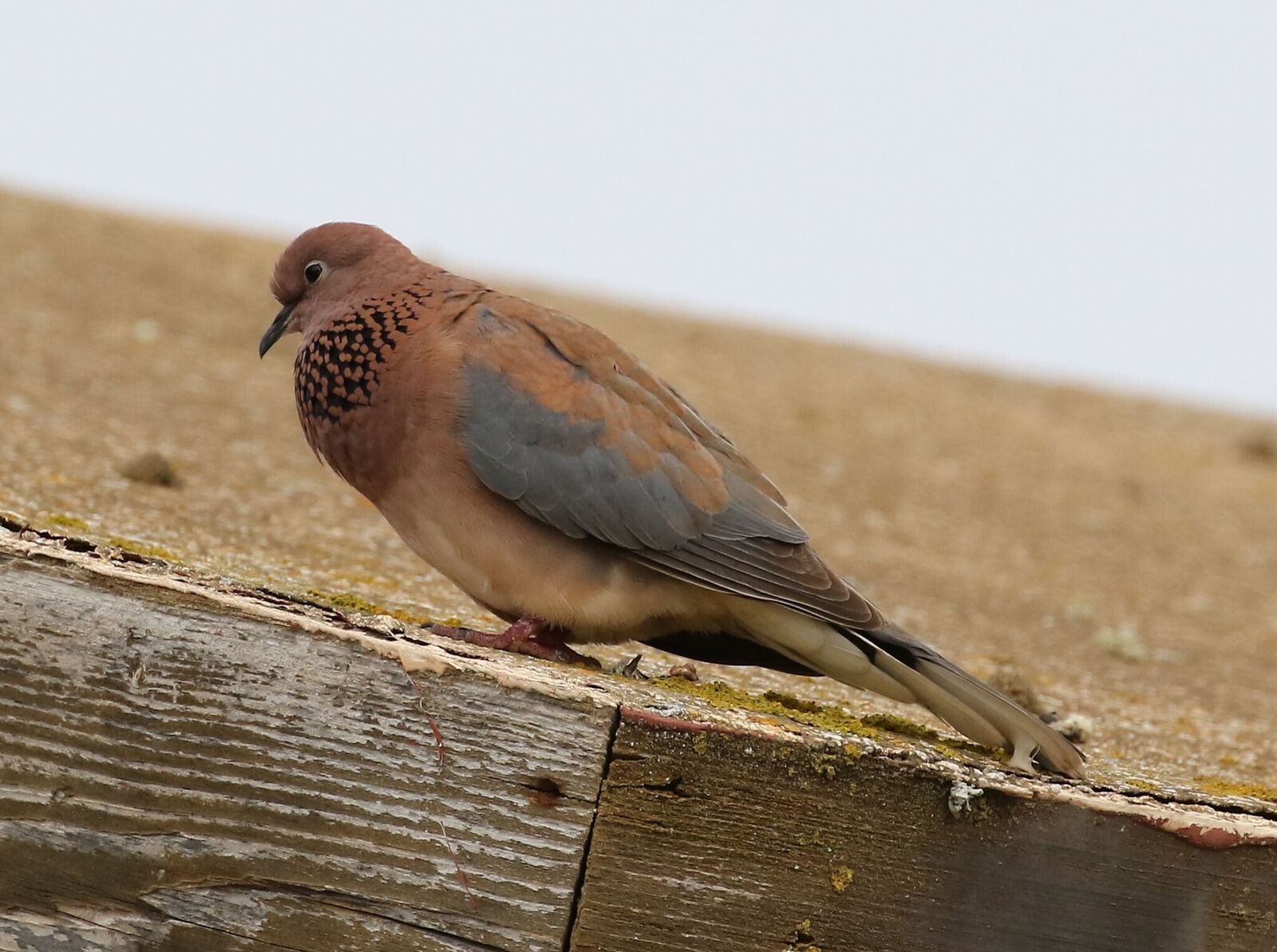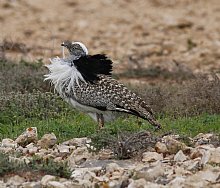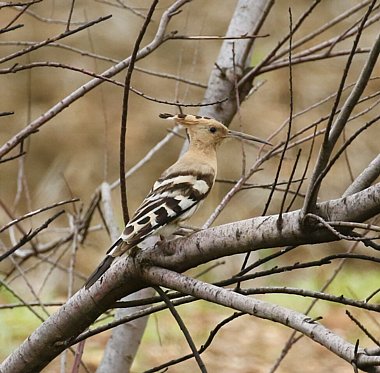NEW! Fuerteventura in Spring
Desert specialities and spring migration in a Canary Islands hotspot
| Destination | |
|---|---|
| Focus | |
| 2026 Dates | |
| Duration | 8 Days |
| 2026 Price | £2395 pp £220 single supplement. Deposit £400 pre-flight airport hotel and lounge are inc. |
| Max Group Size | 7 per guide |
Fuerteventura is the second largest of the Canary Islands and has an arid desert-like landscape with an impressive volcanic, mountainous interior. Known locally as Viejo Pais Canario or 'the old country', it is an exciting destination for migrants where every freshwater pool or lush-green ‘barranco’ is literally an oasis for migrant birds.
This tour has been updated for 2026 and mid-March is a great time to visit, when desert specialities are active and a variety of migrants pass through. Sightings vary from year to year, but desert ‘staples’ include Houbara Bustard, Black-bellied Sandgrouse, Cream-coloured Courser, Stone Curlew, Mediterranean Short-toed lark and Trumpeter Finch. Endemic Canary Islands Stonechat is more often found in scrub habitats, and with only around 1,000 pairs is another important species occurring in a few. accessible select ravines and slopes. Canaries and Madeiran endemic Berthelot’s Pipit can be common, and we also look for Barbary Partridge, African Blue Tit, Southern Grey Shrike, Plain Swift and Spectacled Warbler.
Migration promises to be exciting, and although numbers may be lower than in Mediterranean hotspots such as Cyprus or Lesvos, the location of Fuerteventura off the north-west coast of Africa makes migration a mouth-watering prospect. There are lots of possibilities, and on past visits we have encountered Red-rumped Swallow, Tawny, Tree. Olive-backed and Red-throated Pipit, Turtle Dove, Wryneck, Woodchat Shrike, Yellow-browed Warbler and Bluethroat. The wet areas of the island can and do turn up some very good birds with Marbled and Ring-necked Duck recorded regularly. Waders should be found in good numbers, and we can expect Black-winged Stilt, Kentish and Little Ringed Plover, Greenshank and plenty more. Audouin’s Gull may be encountered on the beaches, with Cory’s and Barolo Shearwater passing offshore and a range of herons possible at both interior wetlands and on the coast. As more and more birders visit, rarities are becoming increasingly recorded and recent ‘showstoppers’ have included African Dwarf Bittern, Red-billed Tropicbird and Menetries’s Warbler!
This is a relaxed holiday, which may feature a couple of optional early morning starts to the hot plains to see birds before the heat haze makes viewing more difficult. Birding is easy, and mostly close to our transport, though some optional short walks will be available. If you want relaxed birding, warm days and the chance to see some exceptional European birds at close range, this holiday, timed to coincide with early migration could be right for you!
Enjoy your complimentary pre-flight overnight hotel before your holiday begins. Full details from our office! Read more about our Pre-flight Service here!
Day 1: Saturday 7 March 2026 – Arrival and first birding
After relaxing in our airport lounge, we fly London to Fuerteventura and transfer by minibus to our hotel for the week. On Fuerteventura great birding is always close by and depending on how much time we have we can start to explore the desert or visit one of the many ‘barranco’s’ on the island.
Day 2: Sunday 8 March - Tindaya Plains
Houbara Bustard is an iconic desert bird, and a real Fuerteventura speciality and in recent years the plains at Tindaya have become one of the best places to look for them. We may even get lucky and see their ‘powder-puff’ display on an early-morning visit, while the Canaries Island sub-species (occurring here and on neighbouring Lanzarote) is a potential future split so definitely a key target! Also in the deserts, we look for stunning Cream-coloured Courser plus Black-bellied Sandgrouse, Mediterranean Short-toed Lark and Berthelot’s Pipit – the latter an endemic to the Canaries and Madeira. Southern Grey Shrike are also likely, while migrants out on the plains can include Tawny Pipit, Greater Short-toed Lark and potential scarcer species such as Desert Wheatear. Later we move into farmland and scrub habitats, where Barbary Partridge becomes a possibility. We often see Stone Curlew and Hoopoe here too, while migrant passerines might include Tree Pipit, Woodchat Shrike and a range of warblers.
Day 3: Monday 9 March - Los Molinos Reservoir
Today we investigate fresh-water pools and scrapes around Los Molinos Dam, where the reservoir and wetlands attract plenty of birds and can also turn up vagrants. Likely species include Ruddy Shelduck, Eurasian Spoonbill, Little Egret, Black-winged Stilt, Little Ringed Plover, Greenshank, Common and Green Sandpiper while rarities such as White-rumped Sandpiper, Marbled Duck, Lesser Scaup and Ring-necked Duck have been seen in the past. Black-bellied Sandgrouse can come to drink at the reservoir and nearby farms, and we watch the skies closely for and declining Egyptian Vulture and Canary Island races of Buzzard and Kestrel. Scrub and bushes around the reservoir can be good for endemic Canary Islands Stonechat. Depending on our progress we may linger here, explore one of the 'barranco’s' or an inland wetland location for migrant herons, wildfowl, waders and passerines.
Day 4: Tuesday 10 March - Jandia Peninsula
We head south to the Peninsula de Jandia today, with seabirds and waders on our mind. Among coastal gatherings of Yellow-legged Gull we look for Audouin’s Gull, while waders can include Kentish and Grey Plover, Sanderling, Dunlin and Whimbrel. Gardens and parks around the peninsula often attract wintering and migrant passerines, and we will certainly spend some time exploring these. Various common warblers and finches are likely, with chances to unearth something rarer such as a Yellow-browed Warbler, Olive-backed Pipit or Little Bunting. Anything is possible in this region, and with a good news network we may have the opportunity to target a rarity or two.
Day 5: Wednesday 11 March - Interior Mountains
Today we head into the spectacular mountain interior of the island where our primary target will be the African Blue Tit. One of numerous subspecies occurring within the Canary Islands chain, also possible today are Laughing Dove plus migrants or wintering species such as Turtle Dove, Wryneck and warblers including Yellow-browed. Later we descend the spectacular mountain roads investigating known sights for Barbary Falcon. Currently considered a Peregrine subspecies, opinion that it may be a species in its own right is divided, but either way it is certainly distinctive, and an enjoyable bird to see! We spend the afternoon visiting nearby 'barranco’s' for Trumpeter Finch, Spectacled and Sardinian Warbler, Berthelot's Pipit and have another chance for Canary Islands Stonechat. We will also visit some salt-pans if time allows for waders and egrets - a pleasant change of habitat.
Day 6: Thursday 12 March - El Jable Dunas National Park
We can't leave Fuerteventura without a short walk through the impressive desert habitat at El Jable Dunas National Park with its Saharan-sized sand dunes! Although birds here are limited, we should get close views of Berthelot's Pipit and Southern Grey Shrike in any areas of scrub. Other sites in the north of the island can be for waders and passing seabirds such as Cory’s and Barolo Shearwater. Also likely are Sandwich Tern and Northern Gannet, while increasingly frequent sightings of Red-billed Tropicbird hint at a small breeding population?! Around the towns we keep a look out for Pallid Swift, testing our identification skills as we try to pick out a Plain Swift.
Days 7: Friday 13 March - Round up day
Fuerteventura is a small island, and though most of our tour has planned we can be flexible and make last minute changes if we hear of a good bird. With no fixed plans for our final day, with time to target any unseen or to gain better views of desert species or search the 'barranco’s' and gardens for migrants. A return visit to a wetland site such as Los Molinos might rove rewarding, with birds constantly changing as they move through the Canaries at this time of year.
Day 8: Saturday 14 March - Departure
Some early morning birding if time allows before we return to the airport for our flight back to the UK.
Please note: all itineraries are given as a guide only. Actual holiday content may vary according to the judgement of your guide, and elements beyond our control (eg weather).
What's included in your holiday price:
- return scheduled flight from London – El Matorral Airport, Fuerteventura, airport taxes, baggage and hand luggage up to airline included limit.
- airport transfers, ground transportation, accommodation and meals as specified.
- the services of Heatherlea leaders.
- The Heatherlea Pre-Flight Service offers everything you need at the airport, including hotels, car parking, airport lounges, regional flights, and upgrades. Let Heatherlea take the strain! Pre-flight airport hotel and lounge included free of charge subject to terms and conditions. Read more....
What's not included in your holiday price:
- travel to and from departure airport before and after holiday, in-flight meal, baggage above airline included limit.
- incidental tips, expenses of a personal nature including drinks and personal insurance.
More holiday information
Accommodation: is in a very comfortable hotel with all rooms en suite. Our groups love this hotel!
Food: Typical Spanish food to a very good standard, and with a wide choice. Vegetarian and other diets are welcome.
Walking: The holiday is not strenuous. Walking can be described as generally very easy, on roads, paths and tracks. Most birding is done close to our vehicle, and even on the longest walks we are never far from the minibuses, should anyone wish to go back.
Weather: Typically, temperatures will range from 18 - 25ºC in the “heat” of the day. Sunshine should be plentiful, but wind, clouds, and rain are possible. Cold weather is unlikely but possible. Fuerteventura can frequently be windy.
Insects: biting insects are not expected, though there are a few mosquito's at this season.
Group size: is restricted to 12 clients maximum.
Flights: are by scheduled airline, from London. We may be able to offer flight arrangements from another airport and/or or quote without flights so you can make your own arrangements. If you wish to add an extension either before or after your holiday, please contact us and we will be happy to arrange this for you.
Other birding and wildlife holidays in Spain
- Mallorca
- Spain - Andalucia for autumn migration and Iberian specialities
- Spain - Birding and Lynx, Andujar plus Coto Donana
- Spain - Catalonia and south-east Aragon
- Spain - Extremadura
- Spain in Early Spring
Why choose Heatherlea for your birding and wildlife holiday in Europe?
Our overseas holidays are planned with care to offer great birding and wildlife, led by capable Leaders who really look after you. Every holiday is run the 'Heatherlea Way', and we hope our Overseas Adventures remind you of the quality and care so many of you enjoy in Scotland. That means rewarding and exciting days in the field, and good quality accommodation and meals, with a real flavour of the country we are visiting. Heatherlea always seek to include the personal touches that make all the difference.
Heatherlea holidays are not ‘dawn to dusk’ expeditions. Our less-intensive approach is ideal for those who want to relax whilst experiencing the best wildlife watching, and wherever possible we organise early or late activity on an optional basis. We also take sensible breaks when in very hot places and regular comfort breaks on every holiday whenever possible. All itineraries are planned carefully around the best wildlife opportunities, and you won’t miss out on memorable wildlife, whilst enjoying relaxed, informal days that are great fun.
The really important part of any wildlife holiday is the experience for you, our valued customer. Heatherlea invest in many things to offer you the best possible service;
- We have been organising birding and wildlife holidays for over 30 seasons, and have a highly experienced and capable office team. We also offer a telephone and email service outside normal office hours.
- Heatherlea overseas holidays have a maximum of 12 clients per trip, putting the emphasis on personal service, and helping you get the best possible experience.
- Our holidays often include things which others might invite you to pay yourself, for instance Departure Taxes and tips to hotels.
- All elements of our holidays are sold under our own licence, ATOL 6113. Under ‘Flight-Plus’ legislation it is a legal requirement of any tour operator to hold an ATOL licence for the supply of any overseas holiday where a flight is involved, if that holiday includes either overseas accommodation and/or car hire. It can be a criminal offence for an operator to book flights as part of a package without an ATOL licence. Heatherlea also hold full Tour Operator Insurance for your added protection.
- Heatherlea is your complete wildlife holiday provider. Our ‘Back Office’ team can organise all your pre-flight and other travel needs. Our specialists will help you book the right services, at the best price. Book holiday extensions through us, and your ATOL protection is extended further. We don’t charge extra for this service.
- Heatherlea is a limited company, registered in Scotland, and registered to pay VAT (applies to all holidays within the European Union).

